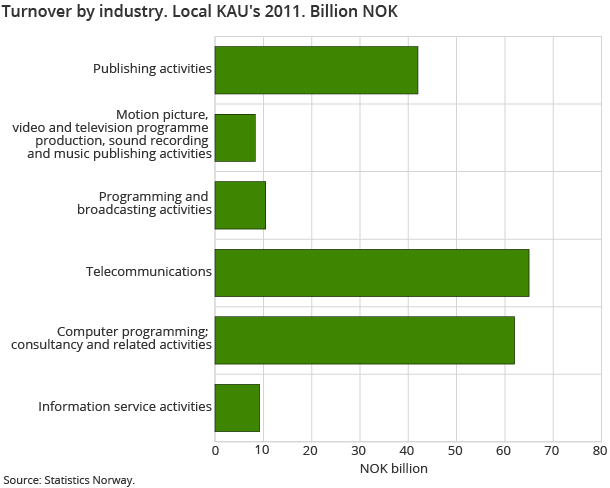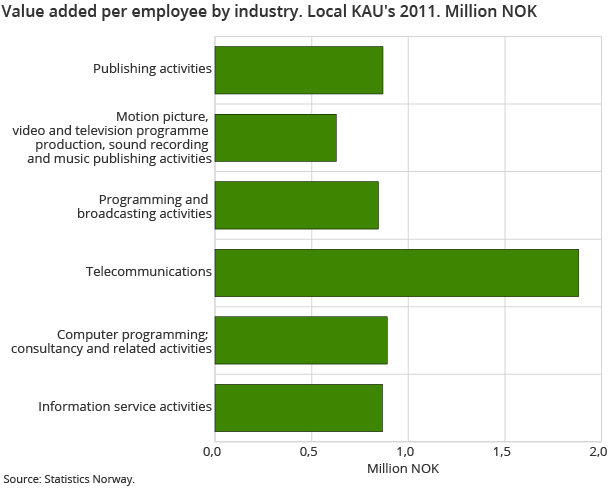Content
Published:
This is an archived release.
Fall in value added for telecommunications
The value added for telecommunication companies fell 3.3 per cent from 2010 to 2011, while employment rose by 1.7 per cent to 13 232 persons.
| 2011 | In per cent | ||
|---|---|---|---|
| 2010 - 2011 | 2009 - 2011 | ||
| Enterprises | |||
| Number of enterprises | 14 415.0 | -1.1 | -0.3 |
| Number of employed | 87 767.0 | 3.0 | 3.8 |
| Turnover (NOK million) | 202 735.7 | 6.8 | 11.6 |
| Value added (NOK million) | 89 091.7 | 4.4 | 9.1 |
| Gross operating surplus (NOK million) | 31 200.6 | -1.2 | 7.6 |
| Local kind-of-activity units | |||
| Number of local KAUs | 15 206.0 | -0.6 | 0.2 |
| Number of employed | 86 898.0 | 2.2 | 3.0 |
| Turnover (NOK million) | 196 938.3 | 4.3 | 9.0 |
| Compensation of employees (NOK million) | 57 500.1 | 7.6 | 9.7 |
| Gross investments (NOK million) | 8 071.0 | -6.5 | -10.7 |
Turnover from telecommunications was NOK 65 billion in 2011. Production value in this industry also fell 4.8 percentage points in the same period. Satellite telecommunications was the only sub-industry in telecommunications to show growth. Turnover increased by 6.8 per cent to NOK 4.8 billion.
Higher value added for computer programming and consultancy
The value added in this industry increased by NOK 2.1 billion; 7.1 per cent up from 2010. Employment went up 5.4 per cent to 35 563 persons. Computer consultancy activities had an increase in value added of 7.7 per cent to NOK 17.8 billion. Computer programming activities had the highest growth in turnover in per cent, with a growth of 14.6 per cent from 2010. Value added increased by 8.4 per cent in 2011.
Fewer companies in publishing
The number of companies in publishing activities fell by 120 to 2 429 from 2010 to 2011. Value added and turnover were at roughly the same level as the year before. Companies in publishing of newspapers had a decrease in their workforce from 8 744 to 8 264 persons; a decline of 5.5 per cent. The value added among companies in software publishing rose by 10.3 per cent to NOK 8.5 billion in the same period.
More employees in media production
The number of employees in motion picture, TV, music production has increased by 4.6 per cent from 4 414 in 2010 to 4 617 in 2011. Production value and value added also had higher values in 2011, especially value added. The production value rose by 9.9 per cent to NOK 8.2 billion, while value added had an increase of as much as 23.8 per cent to NOK 2.9 billion in 2011.
A good year for broadcasting
2011 was a good year for television programming and broadcasting activities. Value added increased by 10 per cent to NOK 4.6 billion. However, 2011 was not such a good year for radio broadcasting. Both the production value and employment were at roughly the same level as in 2010, with NOK 748 million and 542 employees. Value added increased by 11.1 per cent to NOK 366 million from the previous year.
Joint tables available in JuneOpen and readClose
Joint tables including all industry sections, divisions and groups will be published in Statbank on Friday 28 June at 10:00 am.
Comparability between 2010 and 2011Open and readClose
Many enterprises and local KAUs within the industry division Information and communication (J) operate within different industries. The unit is placed in the division in which it has its main activity. If a unit changes its activity it may also have to move to a different industry. This is more common within industry division J than in most other industries. The result is that figures in one year may not necessarily be directly comparable to subsequent years.
The statistics is now published as Business statistics.
Contact
-
Statistics Norway's Information Centre
E-mail: informasjon@ssb.no
tel.: (+47) 21 09 46 42


